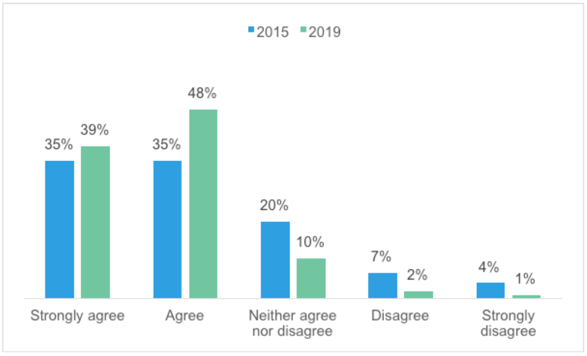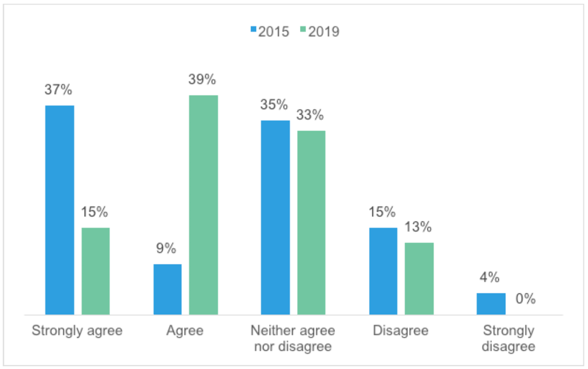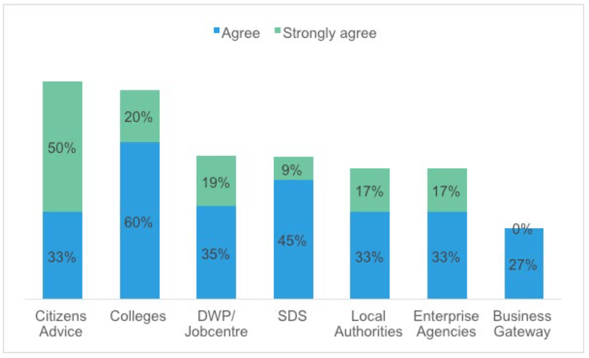PACE partnership review: September 2019
How local PACE partnerships are operating and what current issues they may face.
Communication and Learning
This section looks at how effectively communication works within partnerships, between partnerships and with national agencies. It also looks at partnership experiences of reflective practice and exchanging learning.
Partnership communication
Communication channels and approaches
Effective communication is essential for Partnership Action for Continuing Employment (PACE) Partnerships in responding quickly to local redundancy scenarios. Most PACE Chairs rely on email and phone calls to keep themselves and partners informed. One Chair circulates a monthly report when there has been PACE activity in the local area. However, from our focus groups and interviews, it is clear that existing networks and meetings outside of PACE are important in sustaining partner communication and relationships.
'I will discuss PACE activity/good practice with DWP at our regular bi-monthly meetings.'
From our survey of local PACE Partners, the vast majority of respondents agreed that communication between Skills Development Scotland (SDS) and other partners is effective (87%). This issue shows a significant improvement since this question was asked in 2015 as Figure 7 shows. There was little variation between different partner organisation types, with all largely positive around this aspect of the partnership work.
Figure 7 Whether you agree that communication between SDS and PACE Partners is effective

Source: Local PACE Partner survey 2019 (n=110) and SDS internal data (2015)
National-level communication
Communication with Scottish Government
Stakeholders in several partnerships spoke of challenges communicating with the Scottish Government around major redundancies. Issues cited were lack of consistency, lack of joined up approach and multiple requests for information (often the same information being requested). This tends to occur when there is a sectoral or regional initiative with an interest in the specific redundancy that is working in parallel with PACE. These requests add a time burden to partners who are already stretched in delivering services. These issues come about when Scottish Government staff do not channel their communication through the Scottish Government's PACE policy area within government. One survey respondent also highlighted this point, requesting:
'Clarity on a single point of contact with, and reporting to, Scottish Government on redundancy incidents.'
Support from National PACE team
Partners we spoke to and survey respondents were very positive about the support provided by the national PACE team. They were seen to be responsive and supportive to local partnerships.
'PACE National team keep us abreast of developments, excellent Skype calls, yammer and annual conference. PACE National team communicate well with local partnerships and provide guidance as required.'
One interviewee highlighted a potential role for the national team in collating partnership resources commonly used across partnerships and providing templates that local partners could edit and adapt. There are certain things that partners will all do similarly, so sharing a template version of these would be less resource-intensive and would also be a way of transferring good practice. Examples given included templates for PACE posters, letters, timetables and schedules for one-to-one meetings on sites with multiple partners. Local partnerships could supply examples of ways that they have developed resources to deal with specific issues which could then be made available to other local partnerships.
Another respondent suggested that more support could be offered from the national team around making initial contact with some of the administrators.
Other suggestions included providing logistical support for events and marketing; and providing a directory of specialist advisers such as interpreters.
Reflective learning
From our focus groups, it is clear that some partnership areas are better at sharing learning than others - for example in some areas there were no formal mechanisms in place, and in others they spoke of having a "clean up meeting" after a redundancy situation to reflect on learning and best practice. Among methods of sharing learning at local level, partners identified:
- Case studies
- Word of mouth
- "Good news stories".
- Yammer
- Partnership meetings
Reflective learning at the local partnership level tends to be incorporated into other meetings; either regular partnership meetings (where these take place) or meetings focusing on a specific PACE delivery.
'I share information on events, LMI, mutual partnership working and promote each organisation's courses, activity, information and resources.'
In our survey of local partners, we asked respondents whether they agreed that they had sufficient opportunities to share good practice with other PACE Partners (Figure 8).While more than half either agreed (39%) or strongly agreed (15%); a significant proportion were either neutral (33%) or did not agree (15%). While the responses to this question have shown an improvement since 2015, it is clearly an area where more could be done.
Figure 8 Whether you agree there are sufficient opportunities to share examples of good practice with other PACE Partners

Source: Local PACE Partner survey 2019 (n=110) and SDS internal data (2015)
If we look at the responses by organisation type as Figure 9 shows, representatives of Citizens Advice Bureaux (83%) and Colleges (80%) were more likely to agree that there were sufficient opportunities for sharing good practice. However, representatives of the core partner organisations; Department for Work and Pensions (DWP) (54%), SDS (54%) and local authorities (50%) were less likely to agree with the statement.
Figure 9 Whether you agree there are sufficient opportunities to share examples of good practice with other PACE Partners by organisation type

Source: Local PACE Partner survey 2019 (n=112)
Some of the comments on what partners would like to see included engaging with other areas and partnerships:
'I would like to visit other areas where they have regular PACE Partnership meetings to see what good practice I could bring to my own area.'
'Cross-region links occasionally. We border other local authorities and have customers who travel across boundaries for work.'
Other respondents identified a need for specific meetings or sessions focusing on learning.
'I think more regular meetings of the partners for reflective practice would be helpful. Also to reflect back on delivery as this doesn't happen regularly and could be a learning opportunity.'
'More informal workshops to share good practice.'
This was an issue we also picked up through our focus groups and interviews. Attendees thought it would be useful to develop some written case studies of local good practice, for sharing and communicating with other partners, and for publicity purposes. Online sessions such as webinars might also be an effective way of sharing good practice across rural areas such as Dumfries and Galloway.
Follow-up and impact
Another aspect that partners would like more information on, is follow-up and impact on the support provided. Although information is collected and aggregated by SDS, only limited information is being reviewed at local partnership level. Each organisation tends to have its own system in place for collecting information on impact, but this is generally not collated across the partnership.
'A brief overview of what PACE aims to achieve would be helpful perhaps, and examples of where it has had a positive impact and results. It would be good to receive follow-up reports on individuals assisted and their destinations following redundancy, if known.'
Engagement with national learning/CPD
At the national level there are several methods of sharing learning including:
- National CPD events
- Skype calls for SDS staff every few months
- National conference
- PACE chair events
All the partnerships we spoke to through Focus Groups and interviews had engaged with the national PACE CPD conference. They found the networking and sharing of good practice to be particularly useful. The main feedback we gathered was that such sessions should be more frequent, more accessible or more local. There was some demand for regional learning events that might be a bit more accessible to a wider range of partners. As one PACE Chair responded:
'At the moment not enough of this goes on apart from skype calls that are usually arranged every few months. Be good to have more national and regional face-to-face events/conferences.'
There was also a feeling that it was mainly an SDS event; albeit partners from local authorities, Colleges and DWP had all attended in the past. It was difficult for other organisations to allow the time and travel expenses for representatives to attend. Another respondent suggested that getting a more collaborative approach to developing the CPD events might be useful.
'PACE CPD events from what I understand have been designed by SDS - it would be good to have involvement of others in the design of the days.'
Contact
Email: margaret.sutor@gov.scot
There is a problem
Thanks for your feedback